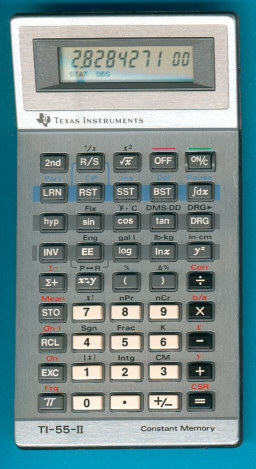
DATAMATH CALCULATOR MUSEUM
 |
DATAMATH CALCULATOR MUSEUM |
Texas Instruments TI-55-II
| Date of introduction: | 1981 | Display technology: | LCD |
| New price: | $50.00 (SRP 1981) | Display size: | 8 + 2 |
| Size: | 5.8" x 3.1" x 0.90" 147 x 79 x 23 mm3 |
||
| Weight: | 3.7 ounces, 106 grams | Serial No: | 210035 |
| Batteries: | 2*LR44 | Date of manufacture: | wk 37 year 1981 |
| AC-Adapter: | Origin of manufacture: | USA | |
| Precision: | 11 | Integrated circuits: | TP0455/CD4505, CD4506 or TP0456/CD4555, CD4556 |
| Memories: | 1-8 | ||
| Program steps: | 56-0 | Courtesy of: | Joerg Woerner |
| Download leaflet: | |
Download manual: | |

![]() With
the TI-55-II Texas Instruments added in 1981 a new calculator line to
the existing slimline series. In you compare the slanted TI-55-II with a typical
slimline calculator like the TI-53, you will
notice some changes:
With
the TI-55-II Texas Instruments added in 1981 a new calculator line to
the existing slimline series. In you compare the slanted TI-55-II with a typical
slimline calculator like the TI-53, you will
notice some changes:
| • Larger display gives 8+2 digits instead 5+2 • 45 keys instead of 40 keys • More space for the electronics |

 The display was not in one line with the keys but slanted
towards the user. Together with a perfect contrast and large digits the
calculator looked very professional. In practice the keyboard of all members of
the slanted scientific/financial calculators was terrible, either bouncing or
without any contact. Most users of the TI-55-II remember: "The -II
designation was evidently for the number of keystrokes that were recorded with
one button press". The calculators were usually replaced for free by Texas
Instruments with TI-55 III's which did not inherit
the bad genes of their forefathers.
The display was not in one line with the keys but slanted
towards the user. Together with a perfect contrast and large digits the
calculator looked very professional. In practice the keyboard of all members of
the slanted scientific/financial calculators was terrible, either bouncing or
without any contact. Most users of the TI-55-II remember: "The -II
designation was evidently for the number of keystrokes that were recorded with
one button press". The calculators were usually replaced for free by Texas
Instruments with TI-55 III's which did not inherit
the bad genes of their forefathers.
Some very early calculators of the second generation were sold
under the old designation TI-55 II with just a missing hyphen. View a very rare
TI-55 II
manufactured in Taiwan here.
 The two-chip design of most slanted calculators allowed more
features compared to the slimline series. The TI-55-II for example added a total
of 8 memories to the basic functions. Find more information about the TP0456
calculator chips here. The TI-88
added a third microcontroller to this Multi-Chip approach.
The two-chip design of most slanted calculators allowed more
features compared to the slimline series. The TI-55-II for example added a total
of 8 memories to the basic functions. Find more information about the TP0456
calculator chips here. The TI-88
added a third microcontroller to this Multi-Chip approach.
Known from the TI-53 and the original TI-55 is the simple programmability, here each memory could be converted to 7 program steps. A nice enhancement was a function to integrate with the Simpson-rule. If you are interested in the calculating accuracy of scientific calculators, don't miss the Calculator forensics.
One calculator in the TI-55-II series - the TI-54 - could manage arithmetic with complex numbers. Once again a "first" from Texas Instruments.
Don't miss an early prototype of the TI-55-II and the famous TI-88.
In Brazil the housing of the TI-55-II was changed to accommodate two AA-sized batteries instead the small coin shaped LR44 type. View this rare beauty here.
The US based company Jeppesen Sanderson developed a very
interesting navigation computer called prostar based on
the TI-55-II.
| TI-55-II
Advanced LCD slide rule calculations with programming and statistics. With 112 powerful functions for professional engineering, science, and math applications. Easy keyboard programmability; including function evaluation and integration features, saves time on repetitive problems. Also the most needed statistical functions for better data analysis. Use up to 8 memories. Built-in conversion functions for fast transition between various measurement systems. Plus: roots, powers, reciprocals, log, trig and hyperbolic functions. Enter data in standard, scientific, or engineering formats. © Texas Instruments, 1981 |
If you have additions to the above article please email: joerg@datamath.org.
© Joerg Woerner, December 5, 2001. No reprints without written permission.